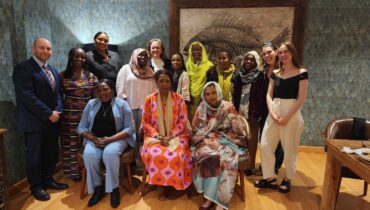Is the age-old axiom that “all is fair in war” really true? International humanitarian law (IHL) offers a very clear answer on this subject: no, it is not. IHL is the body of law that governs armed conflict. It is designed to protect combatants and civilians of all genders by restricting the means and methods of warfare.
In this post, we will explore how IHL can specifically improve outcomes for women in conflict-affected contexts. We will also consider overlaps and synergies between IHL and the women, peace and security (WPS) agenda, drawing on a recent report by the Georgetown Institute for Women, Peace and Security (GIWPS) and a policy brief of the same name: Can the Women, Peace and Security Agenda and International Humanitarian Law Join Forces? (Policy Brief).
What is International Humanitarian Law?
The three core principles of IHL that govern the protection of civilians are distinction, proportionality, and necessity. The principle of distinction requires that forces distinguish between combatants and civilians and only target those determined to be combatants. Proportionality calls on forces not to kill or harm more civilians than is proportional to the anticipated military gain of an operation. The principle of necessity allows for a certain level of civilian harm if it is considered necessary in order to achieve a legitimate military aim.
IHL has a track record of meaningfully protecting the rights of people in conflict-affected areas over the past five decades. As Helen Durham of The International Committee of the Red Cross points out, “prevention is known only in its breaches and not in its adherences…we see [the impact of IHL] every single day when women’s lives are saved and when they get access to treatment through checkpoints.” Yet, IHL does have notable shortcomings and blind spots in its ability to address the gendered dimensions of conflict. While IHL employs nominally gender-neutral language in most cases, it is based on now-outdated views about how men and women are affected by conflict that were commonplace when the founding convention was passed in 1949. For example, the Geneva Conventions frame sexual assault in terms of protecting a woman’s “honor” and “modesty,” and emphasize “protecting” women from assault rather than the prohibiting the perpetration of assault.
IHL is also criticized for failing to recognize the unequal ways that conflict affects men and women. Women in conflict areas often experience more limited freedom of movement, increased care responsibilities, and a greater threat of exploitation. Because of these and other factors, formally equal or gender-neutral laws often fail to produce results that are meaningfully equal in day-to-day life.
IHL also has major blind spots in its failure to address sexual abuse within militaries, as opposed to the assault of civilians by enemy forces. Furthermore, IHL only applies during officially designated “armed conflict” situations. This means that common situations like peacekeeping operations, and “black-site” prisons are not covered by the law. The law also stops applying as soon as official conflict ends, even though widespread violence often continues long after.
Women’s participation and protection as defined by WPS
The WPS agenda, laid out in UNSC Resolution 1325 and a series of subsequent resolutions, focuses on women’s role in securing and maintaining peace and makes explicit reference to IHL. The agenda is organized around the four core pillars of women’s participation, prevention, protection, and relief and recovery. The protection and participation pillars present the clearest overlap with IHL.
The WPS protection pillar calls for the protection of women as civilians and is similar to IHL in its underlying assumption that men are combatants and women are more vulnerable and in need of protection. The participation pillar focuses on increasing the meaningful participation of women in all levels of decision-making related to conflict, security, and peacebuilding, though the resolutions predominantly focus on women’s participation as agents of peace. The resolutions do not explicitly call for increased participation of women in national militaries, but a number of member states have interpreted this as a key part of the agenda.
WPS and IHL synergies
There is room for major progress for women when WPS and IHL frameworks are leveraged simultaneously and used to address one another’s weak spots. For instance, WPS indicates it is important to increase women’s participation in decision-making processes regarding IHL interpretation and compliance, including within the upper ranks of national militaries, the International Committee of the Red Cross, and the International Criminal Tribunals.
Evidence from the corporate and public sectors indicates that demographically diverse groups are better at decision-making because they possess a broader range of knowledge and perspectives. The same could be true in military environments, where bringing women into the conversation could theoretically contribute to higher levels of IHL compliance. There are a number of reasons, including legitimacy and reciprocal compliance, that make complying with IHL a “better” decision for political and military leaders. For these potential gains to be realized, the share of women at all levels of political and military decision-making would need to be increased considerably from the current low levels seen in most countries.
During a GIWPS-led panel discussion on the synergies between WPS and IHL, former U.S. Marine Corps Reserves Captain Zoe Bedell, who was an Officer-in-Charge of the Marine Corps Female Engagement Team in Afghanistan, argued that militaries will include more women if it improves mission effectiveness. Bedell recalled that she and other women in the Marine Corps successfully advocated for their participation in certain missions when they “pitched [themselves] as how [they] can help these infantry units accomplish their mission,” placing the emphasis on efficacy rather than ideological arguments about equality.
Watch the recording of a panel discussion about the synergies between IHL and WPS featuring Ambassador Christian Wenaweser, Dr. Orly Stern, Ms. Emily Kenney, Dr. Helen Durham, Dr. Katrina Lee-Koo, Ms. Zoe Bedell, and Dr. Jeni Klugman. Over 850 viewers joined the discussion from 90 different countries.
“IHL and WPS advocates can work together to build a culture that sees both material and operational, as well as ideational value in compliance.”
-Dr. Katrina Lee-Koo
The protection pillar of WPS could also be expanded by drawing on IHL’s civilian protection principles of distinction, proportionality, and necessity. To date, much of the focus of the protection pillar has been on preventing sexual violence in conflict, which is indeed critical, but also too narrow. Compliance with these principles would protect women by preventing casualties, internal displacement, and the destruction of infrastructure.
Implications for Women in Conflict Zones
Both IHL and WPS are evolving bodies of work. Much of this evolution comes not through formal changes to their foundational texts, but through their continued reinterpretation by practitioners and advocates. This opportunity for evolution is particularly important due to the fact that countries are legally required to comply with IHL. While the authors of the report do not advocate for the merging of these two agendas, there is potential to broaden the focus of the WPS protection pillar to ensure women and girls are safe from all forms of violence, and to use IHL to add legal force to the WPS agenda.
This post was written by GIWPS Research Assistant Emily Sullivan (SFS 2021) and Managing Director Dr. Jeni Klugman.


